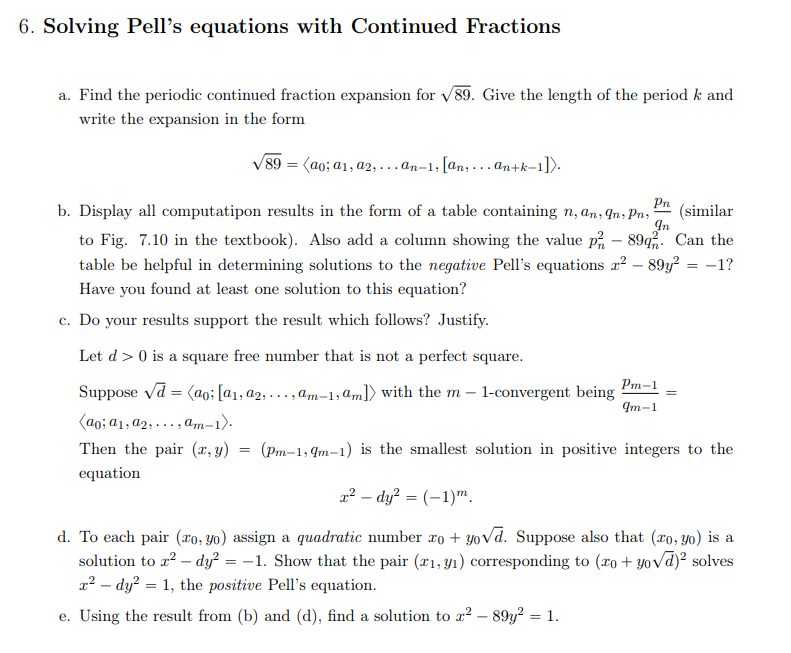Home /
Expert Answers /
Advanced Math /
6-solving-pell-39-s-equations-with-continued-fractions-a-find-the-periodic-continued-fraction-expan-pa851
(Solved): 6. Solving Pell's equations with Continued Fractions a. Find the periodic continued fraction expan ...
6. Solving Pell's equations with Continued Fractions a. Find the periodic continued fraction expansion for \( \sqrt{89} \). Give the length of the period \( k \) and write the expansion in the form \[ \sqrt{89}=\left\langle a_{0} ; a_{1}, a_{2}, \ldots a_{n-1},\left[a_{n}, \ldots a_{n+k-1}\right]\right\rangle . \] b. Display all computatipon results in the form of a table containing \( n, a_{n}, q_{n}, p_{n}, \frac{p_{n}}{q_{n}} \) (similar to Fig. \( 7.10 \) in the textbook). Also add a column showing the value \( p_{n}^{2}-89 q_{n}^{2} \). Can the table be helpful in determining solutions to the negative Pell's equations \( x^{2}-89 y^{2}=-1 \) ? Have you found at least one solution to this equation? c. Do your results support the result which follows? Justify. Let \( d>0 \) is a square free number that is not a perfect square. Suppose \( \sqrt{d}=\left\langle a_{0} ;\left[a_{1}, a_{2}, \ldots, a_{m-1}, a_{m}\right]\right\rangle \) with the \( m-1 \)-convergent being \( \frac{p_{m-1}}{q_{m-1}}= \) \( \left\langle a_{0} ; a_{1}, a_{2}, \ldots, a_{m-1}\right\rangle \). Then the pair \( (x, y)=\left(p_{m-1}, q_{m-1}\right) \) is the smallest solution in positive integers to the equation \[ x^{2}-d y^{2}=(-1)^{m} . \] d. To each pair \( \left(x_{0}, y_{0}\right) \) assign a quadratic number \( x_{0}+y_{0} \sqrt{d} \). Suppose also that \( \left(x_{0}, y_{0}\right) \) is a solution to \( x^{2}-d y^{2}=-1 \). Show that the pair \( \left(x_{1}, y_{1}\right) \) corresponding to \( \left(x_{0}+y_{0} \sqrt{d}\right)^{2} \) solves \( x^{2}-d y^{2}=1 \), the positive Pell's equation. e. Using the result from (b) and (d), find a solution to \( x^{2}-89 y^{2}=1 \).
Expert Answer
By Chegg guidelines we have to solve only firs
